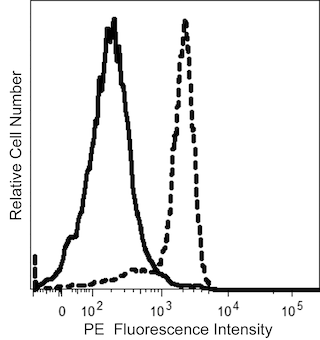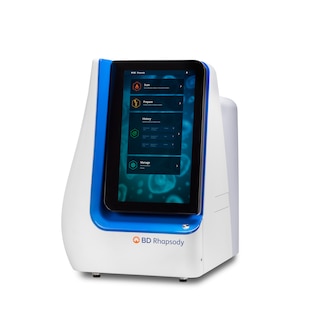-
Your selected country is
Middle East / Africa
- Change country/language
Old Browser
This page has been recently translated and is available in French now.
Looks like you're visiting us from {countryName}.
Would you like to stay on the current country site or be switched to your country?


Oligo Mouse Anti-Human EphB2
Regulatory Status Legend
Any use of products other than the permitted use without the express written authorization of Becton, Dickinson and Company is strictly prohibited.
Preparation And Storage
Recommended Assay Procedures
Put all BD® AbSeq Reagents to be pooled into a Latch Rack for 500 µL Tubes (Thermo Fisher Scientific Cat. No. 4900). Arrange the tubes so that they can be easily uncapped and re-capped with an 8-Channel Screw Cap Tube Capper (Thermo Fisher Scientific Cat. No. 4105MAT) and the reagents aliquoted with a multi-channel pipette.
BD® AbSeq tubes should be centrifuged for ≥ 30 seconds at 400 × g to ensure removal of any content in the cap/tube threads prior to the first opening.
Product Notices
- This reagent has been pre-diluted for use at the recommended volume per test. Typical use is 2 µl for 1 × 10^6 cells in a 200-µl staining reaction.
- Source of all serum proteins is from USDA inspected abattoirs located in the United States.
- Caution: Sodium azide yields highly toxic hydrazoic acid under acidic conditions. Dilute azide compounds in running water before discarding to avoid accumulation of potentially explosive deposits in plumbing.
- The production process underwent stringent testing and validation to assure that it generates a high-quality conjugate with consistent performance and specific binding activity. However, verification testing has not been performed on all conjugate lots.
- Illumina is a trademark of Illumina, Inc.
- Please refer to http://regdocs.bd.com to access safety data sheets (SDS).
- Please refer to bd.com/genomics-resources for technical protocols.
- For U.S. patents that may apply, see bd.com/patents.
Companion Products






The 2H9 monoclonal antibody specifically binds to the Ephrin Type-B Receptor 2 (EphB2). EphB2 is a type I transmembrane glycoprotein that belongs to the Eph receptor family of tyrosine kinase receptors. EphB2 serves as a cell surface receptor tyrosine kinase for membrane-anchored ligands referred to as type B ephrins (ephrin-B). The EphB2 receptor can bind to ephrin-B1, ephrin-B2, and ephrin-B3. Transmembrane ephrin-B family members are key regulators of embryogenesis including development of the nervous and vascular systems. The EphB2 receptor functions as a chemodirectant in regulating cellular migration. EphB2/ephrin-B interactions orchestrate cell positioning by regulating cellular adhesion and repulsion during development, thereby influencing cell fate, morphogenesis and organogenesis. Signaling can occur in a forward pathway when the EphB2 receptor tyrosine kinase is activated by bound ligand and in a reverse pathway when transmembrane ephrin-B ligands are activated by EphB2 receptor-mediated crosslinking. In the adult body, Eph receptor signaling plays major roles in regulating the architecture and physiology of different tissues under normal as well as disease conditions such as cancer. Ephrin-B1 and ephrin-B2 levels are upregulated in the vasculature during inflammation. Ephrin-B2 molecules that are localized to the luminal endothelial surface can signal through the EphB2 which is expressed by monocytes. This interaction promotes monocyte differentiation into proinflammatory macrophages. In the intestinal epithelium, EphB2/ephrin-B interactions regulate both cell positioning and tumor progression. The differential expression patterns of EphB2 allows for the detection and isolation of various intestinal epithelial cell types. These include intestinal stem cells (ISCs) which express high levels of EphB2. The 2H9 antibody reportedly blocks the interaction of EphB2 with ephrin ligands and crossreacts with mouse EphB2.
Development References (6)
-
Foster KE, Gordon J, Cardenas K, et al. EphB-ephrin-B2 interactions are required for thymus migration during organogenesis.. Proc Natl Acad Sci USA. 2010; 107(30):13414-9. (Biology). View Reference
-
Jung P, Sato T, Merlos-Suárez A, et al. Isolation and in vitro expansion of human colonic stem cells. Nat Med. 2011; 17(10):1225-1227. (Biology). View Reference
-
Liu H, Devraj K, Möller K, Liebner S, Hecker M, Korff T. EphrinB-mediated reverse signalling controls junctional integrity and pro-inflammatory differentiation of endothelial cells. Thromb Haemost. 13(112)(Biology). View Reference
-
Mao W, Luis E, Ross S, et al. EphB2 as a therapeutic antibody drug target for the treatment of colorectal cancer. Cancer Res. 204; 64(3):781-788. (Immunogen: Blocking, Cytotoxicity, Depletion, ELISA, Flow cytometry, Fluorescence microscopy, Functional assay, Immunofluorescence, Inhibition, In vivo exacerbation, Neutralization, Radioimmunoassay). View Reference
-
Merlos-Suárez A, Barriga FM, Jung P et al. The intestinal stem cell signature identifies colorectal cancer stem cells and predicts disease relapse. Cell Stem Cell. 2011; 8(5):511-524. (Clone-specific: Flow cytometry). View Reference
-
Pasquale EB. The Eph family of receptors. Curr Opin Cell Biol. 1997; 9(5):608-615. (Biology). View Reference
Please refer to Support Documents for Quality Certificates
Global - Refer to manufacturer's instructions for use and related User Manuals and Technical data sheets before using this products as described
Comparisons, where applicable, are made against older BD Technology, manual methods or are general performance claims. Comparisons are not made against non-BD technologies, unless otherwise noted.
For Research Use Only. Not for use in diagnostic or therapeutic procedures.
Report a Site Issue
This form is intended to help us improve our website experience. For other support, please visit our Contact Us page.